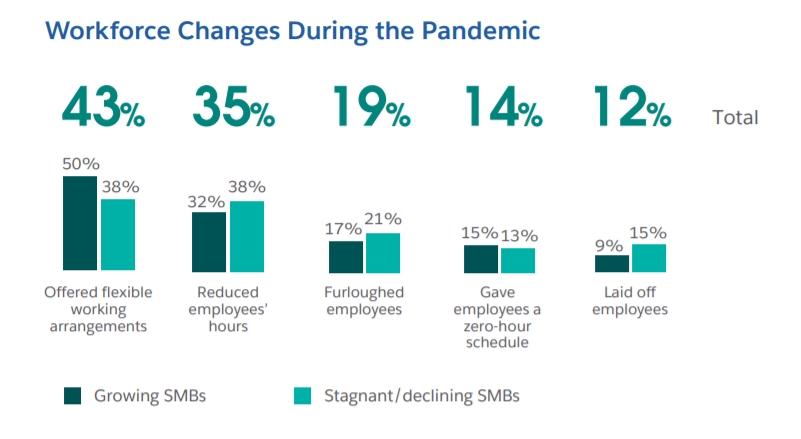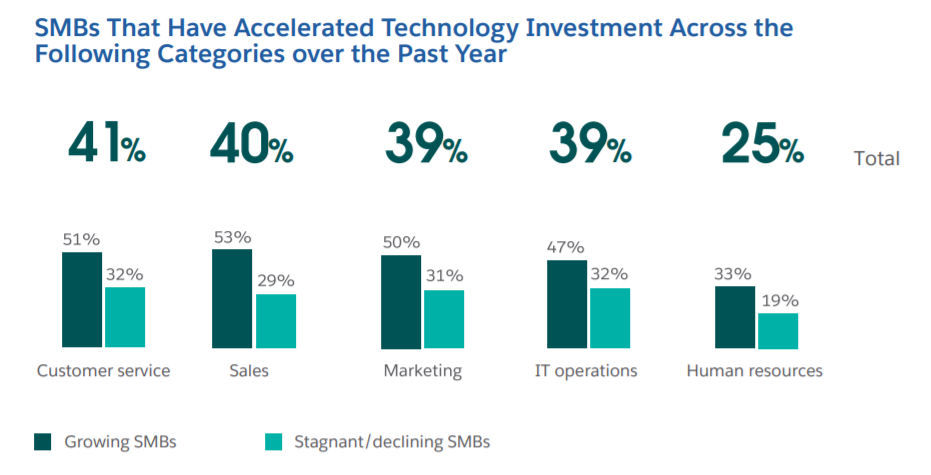The fifth edition of the Small and Medium Business Trends report reveals a prescient new concern: keeping employees engaged. While much has been made of the recent trend towards customer-centricity, the shift towards becoming more employee-centric has been equally important. In a time when workforces are increasingly decentralised, SMEs need to keep them on board, on track and on side.
Luckily, there’s a simple way to build trust and drive engagement: employee benefits for small businesses. By offering employee benefits for small businesses, organisations can attract and retain talent. They can show their workforces that they care about their wellbeing, as well as build more meaningful long-term relationships. But how can SMEs make sure they’re offering the right employee benefits? And can they really afford to do so?
Why should SMEs offer employee benefits for small businesses?
There are a number of good reasons for SMEs to offer robust employee benefits. For one, studies have shown that employee satisfaction is integral for providing good customer service. And keeping the customer happy is a catalyst for sustainable growth.
Additionally, offering good employee benefits can help SMEs -
Increase employee retention and reduce the costs of recruiting.
Stand out from the crowd and build a reputation for being a great place to work.
Be more attractive to the talent that left their jobs in the ‘Great Resignation’.
Boost morale and productivity in a workforce that feels appreciated.
Offering attractive benefits is a win for both SMEs and their employees. And in a post-pandemic climate of uncertainty, stress, and potential disconnection, supporting the workforce is critical.
What employee benefits packages can small businesses provide?
The pandemic made flexible working a hot topic, and the shift away from the office will likely be a permanent one. The Small and Medium Business Trends report reveals that –
50% of growing SMEs offered flexible working arrangements during the pandemic.
Only 38% of stagnant/declining SMEs did the same.
The report also shows that having a flexible schedule tops the list of employees’ expectations. The ability to work remotely also ranks in the top five. SMEs that are not able to meet these expectations will find it increasingly difficult to retain and attract talent. The benefits of creating an ‘anytime, anywhere workplace’ are becoming more and more evident.
In addition to a flexible working environment, some other employee benefits for small businesses might include gym memberships, wellness stipends, travel vouchers, and perks as simple as free snacks and drinks.
Why is it important to maintain high employee engagement?
Employee engagement and productivity are intertwined. And for SMEs, getting the most out of their resources is important for staying competitive.
The cost of replacing an employee can be up to 200% of their annual salary.
Studies have estimated that disengaged employees cost the UK economy £340 billion.
Engaged teams are 21% more profitable.
Employee benefits for small businesses provide SMEs with a way to drive employee engagement and keep employees satisfied. Not only are engaged employees more productive, they’re also less likely to look for new jobs.
Why is technology important for employee engagement?
We’re well into the digital revolution and today’s workers are an ambitious bunch. They’re interested in bettering themselves and using new tools. This is great for businesses, as a highly trained workforce is one that’s well-prepared for emerging challenges. But it also means that SMEs should be proactive in providing new opportunities and technologies.
The SME Trends report shows that 71% of growing SMEs say they survived the pandemic because of digitisation. Additionally, 51% increased their technology investment in customer service and 53% increased it in sales.
Technology is the great enabler. Workforces that aren’t being offered new tools and training may be getting left behind in a digital-first landscape. And SMEs that aren’t offering them face the prospect of falling into the digital skills gap, as 60% of businesses believe that their reliance on digital skills is set to increase over the next five years. Moreover, employees without these tools are not as productive as they might be, as they’re forced to spend time on routine, low-value tasks that could easily be automated by AI solutions.
Introducing online training courses and digital upskilling and reskilling programmes can be a good way for SMEs to empower their workforce. Even better, this training can be done from anywhere at any time. When it comes to employee benefits for small businesses, offering the right tech and training is a win/win for both SMEs and their workforces.
Four ways to optimise employee benefits for small businesses
One of the business world’s most well-known mottos is ‘the customer is king’. And while the customer is certainly the north star for many SMEs, it’s important to look inwards as well. Businesses that treat their employees as well as they treat their customers are positioning themselves for the long haul.
Here are four ways that SMEs can optimise their employee benefits.
Create an environment that can flex with the worker. By creating a flexible workplace that can adapt to the needs of a post-pandemic workforce, SMEs can reduce anxiety and increase productivity. SMEs that are considering implementing a remote or hybrid approach to working are not alone, as 43% of SMEs say that their long-term plans for working arrangements are to work ‘from anywhere’.
Increase annual leave. Not all SMEs can afford to increase annual leave, but it can be an effective way to improve retention and productivity. An increase in annual leave doesn’t have to be large. For example, just giving employees a day off for their birthday can help them recharge – especially if you throw in vouchers for restaurants or experiences.
Offer wellness-related perks. Offering health-related employee benefits for small businesses can win over the workforce and lead to fewer sick days. For example, think about introducing cycling schemes, 15-minute daily yoga breaks or rewards programmes based on hitting daily step goals, to name just a few possibilities.
Introduce health care benefits. Companies that offer private healthcare packages and perks can be very attractive to new talent. Onsite masseuses and dentists might not be in the budget for most SMEs, but online fitness or spinning classes might be. The rise of digital doctors during the pandemic has also made virtual care a popular option.
Appropriate employee benefits might also depend on the type of business you’re in. But whatever benefit offerings you choose, make sure that your workforce and any potential recruits know what you offer.
Create a happier workplace, build a better business
Everyone wants to be appreciated. A good benefits package shows workers that you care. And if these benefits lead to a more content worker, they can help drive productivity. Better yet, if those benefits empower the workforce with new technologies and skills, it can increase business agility and resilience. For SMEs and their workforce, the future is trending in the right direction.
To see more trends driving the business landscape, download the fifth edition of the Small and Medium Business Trends report here.











